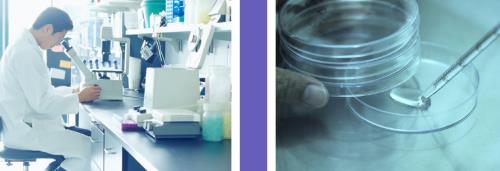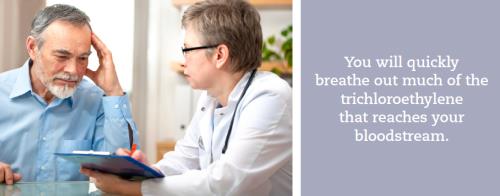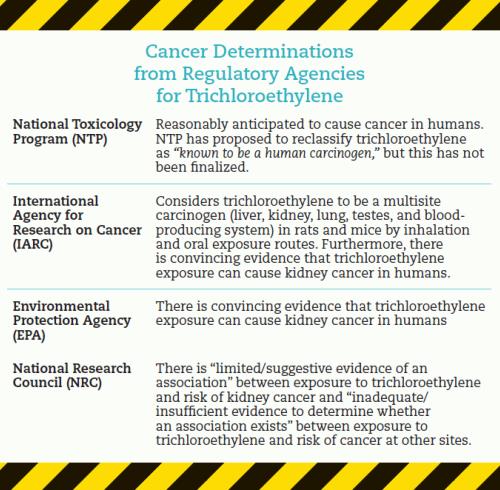
Trichloroethylene
Trichloroethylene Overview
Trichloroethylene is a colorless, volatile liquid.
Liquid trichloroethylene evaporates quickly into the air. It is nonflammable and has a sweet odor.
The two major uses of trichloroethylene are as a solvent to remove grease from metal parts and as a chemical that is used to make other chemicals, especially the refrigerant, HFC-134a. Trichloroethylene has also been used as an extraction solvent for greases, oils, fats, waxes, and tars; by the textile processing industry to scour cotton, wool, and other fabrics; in dry cleaning operations; and as a component of adhesives, lubricants, paints, varnishes, paint strippers, pesticides, and cold metal cleaners.
Trichloroethylene and the Environment
Trichloroethylene can be released into the air, water, and soil at places where it is produced or used.
 Trichloroethylene is commonly found in outdoor air at levels far less than 1 part per million (ppm). Trichloroethylene levels of approximately 1–100 ppm have been measured in workplace air at facilities that use trichloroethylene for metal degreasing. Trichloroethylene levels as high as 20 parts per billion (ppb) have been measured in air inside homes and public places. Trichloroethylene is broken down quickly in air. People who live near facilities that use trichloroethylene or near hazardous waste sites containing trichloroethylene may have a higher exposure to this substance.
Trichloroethylene is commonly found in outdoor air at levels far less than 1 part per million (ppm). Trichloroethylene levels of approximately 1–100 ppm have been measured in workplace air at facilities that use trichloroethylene for metal degreasing. Trichloroethylene levels as high as 20 parts per billion (ppb) have been measured in air inside homes and public places. Trichloroethylene is broken down quickly in air. People who live near facilities that use trichloroethylene or near hazardous waste sites containing trichloroethylene may have a higher exposure to this substance.
Trichloroethylene has been found in drinking water samples at many locations in the United States. Levels at these locations are typically less than 30 parts per billion (ppb). Trichloroethylene breaks down slowly in surface water and is removed mostly through evaporation to air. Trichloroethylene can slowly enter groundwater from contaminated surface water. Trichloroethylene is expected to remain in groundwater for long periods of time since it is not able to readily evaporate from groundwater.
Trichloroethylene can also move through soil and contaminate groundwater. Trichloroethylene breaks down slowly in soil and is removed mostly through evaporation to air. Trichloroethylene in soil (and to some extent in groundwater) may evaporate and migrate into air spaces beneath buildings to enter the indoor air, a process termed vapor intrusion. Top of Page
Exposure to Trichloroethylene
Trichloroethylene can enter your body from the air, water, or soil.
 You are most likely to be exposed to trichloroethylene by drinking trichloroethylene-contaminated water; you may also be exposed by breathing trichloroethylene released to the air from trichloroethylenecontaminated water. If you work in the degreasing industry or other industry where trichloroethylene is used, you may be exposed by breathing in trichloroethylene-contaminated air or by contacting the chemical with your skin.
You are most likely to be exposed to trichloroethylene by drinking trichloroethylene-contaminated water; you may also be exposed by breathing trichloroethylene released to the air from trichloroethylenecontaminated water. If you work in the degreasing industry or other industry where trichloroethylene is used, you may be exposed by breathing in trichloroethylene-contaminated air or by contacting the chemical with your skin.
Trichloroethylene in air can easily enter your body when you breathe. Most of the trichloroethylene that you breathe in will go into your bloodstream and into other organs. A small amount of trichloroethylene in the air can also move through your skin and into your bloodstream.
When trichloroethylene is found in water, it can enter your body when you drink or touch the water or when you breathe in steam from the water. Most of the trichloroethylene that you breathe in or drink will move from your stomach or lungs into your bloodstream. When you touch water containing trichloroethylene (such as showering or bathing with trichloroethylene-contaminated water), some of it can get through your skin into your body.
You can also be exposed to trichloroethylene in soil when small amounts of soil are transferred to your mouth accidentally, when your skin touches the soil, or when you breathe air or dust coming from the soil.
Trichloroethylene has been detected in table-ready foods at concentrations generally in the range of 2–100 ppb. Top of Page
Trichloroethylene and the Body
Once in your blood, your liver changes much of the trichloroethylene into other chemicals.
When the body absorbs more trichloroethylene than it can break down quickly, some of the trichloroethylene or its breakdown products can be stored in body fat for a brief period. However, once absorption ceases, trichloroethylene and its breakdown products quickly leave the fat.
You will quickly breathe out much of the trichloroethylene that reaches your bloodstream; most of the trichloroethylene breakdown products leave your body in the urine within a day.
The health effects of trichloroethylene depend on how much trichloroethylene you are exposed to and the length of that exposure. Environmental monitoring data suggest that any trichloroethylene levels the public might encounter by direct contact or through air, water, food, or soil, are generally much lower than the levels at which adverse effects are elicited in animal studies.
Health Effects of Exposure
Trichloroethylene was once used as an anesthetic for surgery.
People who are overexposed to moderate amounts of trichloroethylene may experience headaches, dizziness, and sleepiness; large amounts of trichloroethylene may cause coma and even death. Some people who breathe high levels of trichloroethylene may develop damage to some of the nerves in the face. Other effects seen in people exposed to high levels of trichloroethylene include evidence of nervous system effects related to hearing, seeing, and balance, changes in the rhythm of the heartbeat, liver damage, and evidence of kidney damage. Some people who get concentrated solutions of trichloroethylene on their skin develop rashes.
Relatively short-term exposure of animals to trichloroethylene resulted in harmful effects on the nervous system, liver, respiratory system, kidneys, blood, immune system, heart, and body weight.
Exposure to trichloroethylene in the workplace may cause scleroderma (a systemic autoimmune disease) in some people. Some men occupationally-exposed to trichloroethylene and other chemicals showed decreases in sex drive, sperm quality, and reproductive hormone levels.

Long-term exposure studies in animals have mainly focused on carcinogenicity and relatively insensitive noncancer end points following oral exposure; these studies are not helpful in defining noncancer end points in humans following long-term exposure. However, depressed body weight and evidence of effects on the thymus were reported in one recent study of mice exposed to trichloroethylene via their mothers during gestation and lactation and via the drinking water for up to 12 months thereafter.
There is strong evidence that trichloroethylene can cause kidney cancer in people and some evidence that it causes liver cancer and malignant lymphoma (a blood cancer). Lifetime exposure to trichloroethylene resulted in increased liver cancer in mice and increased kidney cancer in rats at relatively high exposure levels. There is some evidence for trichloroethylene-induced testicular cancer and leukemia in rats and lymphomas and lung tumors in mice.
Trichloroethylene and Children
Trichloroethylene is expected to affect children in the same manner as adults.
 It is not known whether children are more susceptible than adults to the effects of trichloroethylene.
It is not known whether children are more susceptible than adults to the effects of trichloroethylene.
Some human studies indicate that trichloroethylene may cause developmental effects such as spontaneous abortion, congenital heart defects, central nervous system defects, and small birth weight. However, these people were exposed to other chemicals as well. In some animal studies, exposure to trichloroethylene during development may have caused effects such as decreased body weight, increased incidences of heart defects, functional or structural changes in the developing nervous system, and effects on the immune system.
Reducing Risk of Exposure
If your doctor finds that you have been exposed to significant amounts of trichloroethylene, ask whether your children might also be exposed. Your doctor might need to ask your state health department to investigate.
Exposure to contaminated drinking water should be limited. Trichloroethylene has been detected in some drinking water supplies. For bottled water, consumers should contact the bottler with specific questions on potential contaminants.
If you live near an industrial site where trichloroethylene is produced or is a byproduct or you live near a hazardous waste site where it has been discarded, there may be high levels of trichloroethylene in the water and soil. If you find your home water supply and/or soil to be contaminated with trichloroethylene, consider using a cleaner source of water and limiting contact with soil (for example, through use of a dense ground cover or thick lawn) to reduce exposure to trichloroethylene. Produce grown in contaminated soil should not be eaten. By paying careful attention to dust and dirt control in the home (air filters, frequent cleaning), you can reduce family

exposure to contaminated dirt. Some children eat a lot of dirt. You should prevent your children from eating dirt. You should discourage your children from putting objects in their mouths. Make sure that children wash their hands frequently and before eating. Discourage your children from putting their hands in their mouths or from other hand-to-mouth activity.
Trichloroethylene is widely used as a solvent for extraction, waterless drying, and finishing, and as a general purpose solvent in adhesives, lubricants, paints, varnishes, paint strippers, pesticides, and cold metal cleaners. Follow instructions on product labels to minimize exposure to trichloroethylene.
Exposure Testing
Trichloroethylene and its breakdown products (metabolites) can be measured in blood and urine.
However, the detection of trichloroethylene or its metabolites cannot predict the kind of health effects that might develop from that exposure, partly because exposure to other chemicals can produce byproducts similar to those observed following exposure to trichloroethylene. Because trichloroethylene and its metabolites leave the body fairly rapidly, the tests need to be conducted within a few hours after exposure. Tests for trichloroethylene and its metabolites in the blood or urine require special analytical equipment not readily available at medical facilities.
Governmental Recommendations
Recommendations and regulations are also updated periodically as more information becomes available. For the most current information, check with the federal agency or organization that issued the regulation or recommendation.
Some regulations and recommendations for trichloroethylene include:
Additional Information
If you have any more questions or concerns, please contact your community or state health or environmental quality department or contact ATSDR at the address and phone number below.
Agency for Toxic Substances and Disease Registry
Division of Toxicology and Human Health Sciences
1600 Clifton Road NE, Mailstop F-57
Atlanta, GA 30329-4027 Toll-free information and technical assistance:
1-800-CDCINFO (1-800-232-4636) Top of Page

- Page last reviewed: October 14, 2015
- Page last updated: October 14, 2015
- Content source:



 ShareCompartir
ShareCompartir





